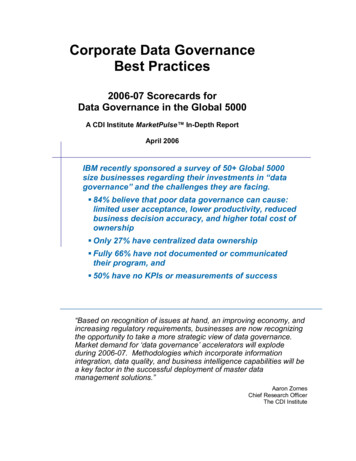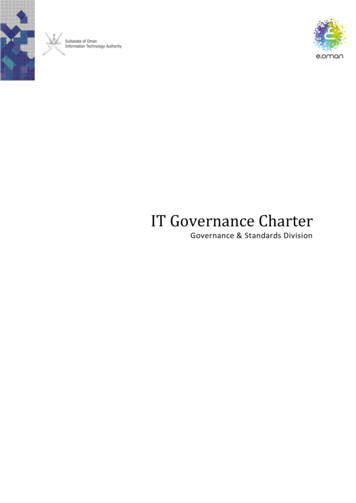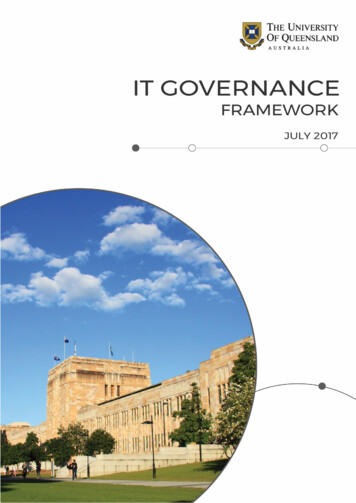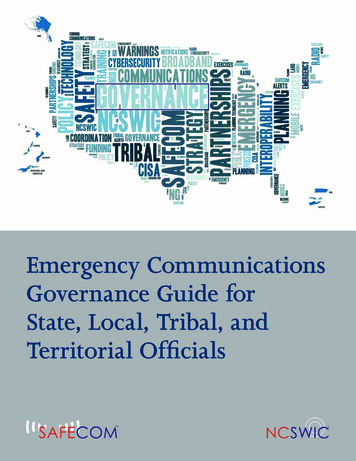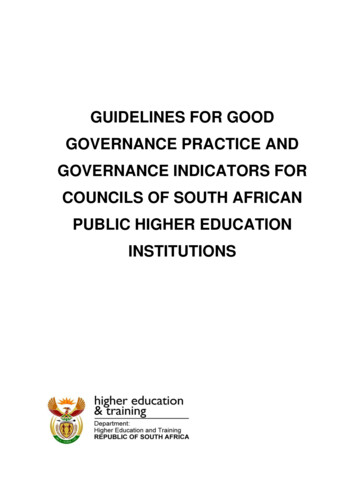
Transcription
GUIDELINES FOR GOODGOVERNANCE PRACTICE ANDGOVERNANCE INDICATORS FORCOUNCILS OF SOUTH AFRICANPUBLIC HIGHER EDUCATIONINSTITUTIONS
Prepared by Directorate: Institutional Support and Sector LiaisonDepartment of Higher Education and Training123 Francis Baard StreetPretoria0001Private Bag X174Pretoria 0001Website: http://www.dhet.gov.zaPublished by the Department of Higher Education and TrainingCopyright Department of Higher Education and Training, 2017Enquiries:Director: Institutional Support and Sector LiaisonEmail: info.issl@dhet.gov.zaTelephone: 012 312 5251/39Guidelines for Good Governance Practice and Governance Indicators for Councils of South African Public Higher EducationInstitutions: Approved by the Minister of Higher Education and Training, Professor HB Mkhize, MP, on 13 December 20172
FOREWORDOver the past several years, independent assessors have been appointed for a number ofuniversities in terms of the Higher Education Act (Act No 101 of 1997, as amended) as a result ofpoor institutional governance and mismanagement. The work done by the independent assessorsrevealed serious challenges with regard to governance, administration and management of someuniversities that were destabilising and undermining the effective functioning of the institutions.Various governance failings stemmed from amongst others, inexperience and lack of the requiredexpertise among some of the council members towards the fulfilment of their governance andfiduciary role; fraught relationships between councils and executive management and members ofstaff; failure of leadership especially at the level of the chairpersons of councils; unacceptable andcounter-productive conduct by some council members; and non-adherence to proper meetingprocedures.As a result of these governance challenges in the system, for the 2014-2019 Medium Term StrategicFramework, government committed to develop governance indicators and monitor governancepractices of universities. These challenges have also provided the context within which the DHETand the Committee set out to draft this document, and have influenced both the approach andcontent.The process of developing this document was started in November 2015 through a brainstormingmeeting between the Department and a group of sector stakeholders namely, former administrators,researchers, some university registrars, representatives from the Council on Higher Education(CHE), Universities South Africa (USAf) and University Chairs of Council Forum-SA (UCCF-SA). Themain objectives of the meeting were to initiate a dialogue on the development of indicators that willbe used to measure the state of governance at universities; to set up a process and discuss theprinciples for the development of the indicator or a guide to good governance framework.Following the brainstorming meeting, a Committee consisting of Professor Themba Mosia, ProfessorRolf Stumpf, Dr Jairam Reddy, Dr Jeffrey Mabelebele and Dr Denyse Webbstock was establishedto develop governance indicators.Governance challenges continue to plague some universities, and there is a need for a code of goodgovernance practices for university councils. It was therefore resolved that indicators on their ownwill not be very useful to the system without a code of good governance. Hence the document titled“Guidelines for Good Governance Practice and Governance Indicators for Councils of SouthAfrican Public Higher Education Institutions”.Guidelines for Good Governance Practice and Governance Indicators for Councils of South African Public Higher EducationInstitutions: Approved by the Minister of Higher Education and Training, Professor HB Mkhize, MP, on 13 December 20173
The first draft document was approved by the Director-General in March 2017 for consultation. Itwas discussed and debated in a consultation workshop with council chairpersons, vice-chancellors,registrars (as secretaries of councils), USAf and the CHE. The workshop drew many comments andrecommendations on how the guidelines and indicators may be improved. Comments were receivedthrough discussions during & after the workshop; evaluation forms and written submissions frominstitutions subsequent to the workshop. All comments were read and considered. Some, notunexpectedly, contradicted one another, and not all the suggestions were incorporated into thissecond draft. However, all enriched the deliberations and invoked other processes which the DHETmay embark upon to improve the overall governance of the system.We acknowledge other distinctive codes that are available to advise and guide on the path to bettergovernance such as the King Reports on Corporate Governance for South Africa which contain verygood principles of good governance. However, these may not be entirely applicable to the highereducation setting. Hence the need to develop Guidelines for Good Governance Practiceaccompanied by a set of indicators specific to councils of public higher education institutions.Councils are the highest decision-making bodies of public higher education institutions. They areresponsible for the good order and governance of institutions and for their mission, financial policy,performance, quality and reputation. The Guidelines for Good Governance Practice sets out theprinciples and key elements of good governance practices, which can serve as a valuable andpractical resource to university councils in their governance role. The indicators are purposefullydesigned for self-assessment by university councils to measure their practices on primary areas ofgovernance. The indicators are by no means, designed with a view to create a form of a rankingsystem for comparing institutions.We trust that this document will contribute to a revitalization of governance practices at highereducation institutions. Governing of a university needs to be carried out with integrity and care.Failure to effectively govern can be the undoing of an institution. On various occasions when aMinister has had to intervene, there are accusations of encroachment on institutional autonomy.Under certain extreme circumstances and after following due process and procedure outlined in theHigher Education Act, the Minister may intervene especially when a council has failed to dischargeits duties. This is a provision no Minister has joy in applying. The Ministry’s oversight role does notinvolve responsibility for the micro-management of institutions however it does justify directintervention when such is in the interest of ensuring public accountability regarding the use of fundsor preventing mismanagement. We have to always remember that institutional autonomy should beexercised in tandem with public accountability as clearly articulated in the White Paper. GovernmentGuidelines for Good Governance Practice and Governance Indicators for Councils of South African Public Higher EducationInstitutions: Approved by the Minister of Higher Education and Training, Professor HB Mkhize, MP, on 13 December 20174
invests vast amounts of public resources to ensure that institutions contribute to nationaldevelopment goals and this has to be met by a degree of accountability to the South African public.One of the reasons I am putting emphasis on improving governance of universities, is the need toensure that our universities do not become hubs for corrupt practices. The success of a public highereducation institution rests, to a large extent, on accountable and effective governance and soundmanagement practices.I approve this revised draft document for institutions to pilot - to use the guide to benchmark theircouncil practices and the indicators for self-assessment. The assessment scorecard should besubmitted to the DHET for analysis that will set a baseline for the system. This is a living documentthat will be continuously reviewed and improved periodically, as and when deemed necessary.I would like to thank everyone who has contributed to the development of this document. A specialword of thanks to Professor Rolf Stumpf who put together this document.Professor HB Mkhize, MPMinister of Higher Education and Training,Guidelines for Good Governance Practice and Governance Indicators for Councils of South African Public Higher EducationInstitutions: Approved by the Minister of Higher Education and Training, Professor HB Mkhize, MP, on 13 December 20175
TABLE OF CONTENTSFOREWORD . 3ACRONYMS . 8CHAPTER 1. INTRODUCTION . 9CHAPTER 2. REGULATORY FRAMEWORK FOR INSTITUTIONAL GOVERNANCE . 122.1 University governance and the Report of the National Commission on HigherEducation (NCHE) (1996) . 122.2 University governance in the White Paper on Higher Education (1997) . 142.3 Governance and the Higher Education Act, No 101 of 1997 . 152.4 Governance and institutional ‘Reporting Regulations’ . 172.5 Governance and Institutional Statutes and Institutional Rules . 18CHAPTER 3. COOPERATIVE GOVERNANCE FOR PUBLIC HIGHER EDUCATION . 203.1 National Level . 203.2 Institutional Level . 21CHAPTER 4. ASSESSMENT OF AND FAILURES IN GOVERNANCE AT SOUTHAFRICAN PUBLIC UNIVERSITIES . 244.1 Introduction . 244.2 Inadequate leadership . 244.3. Role confusion and contestation . 254.4 Factionalism and internal divisions . 254.5 Non-adherence to rules and procedures . 264.6 Council / Vice-chancellor relationships . 274.7 Other governance challenges . 284.7.1 ‘Stakeholderisation’ . 284.7.2 Appointment of council members . 294.7.3 Size of councils . 29CHAPTER 5. INTERNATIONAL EXAMPLES OF UNIVERSITY GOVERNANCE . 305.1 United Kingdom . 305.2 Denmark. 325.3 Ireland . 335.4 Australia. 335.5 United States of America (USA) . 365.6 Council size and composition for a number of international universities . 36CHAPTER 6. PROVISIONS REQUIRED FOR ENSURING GOOD GOVERNANCE. 376.1 Introduction . 376.2 Council’s composition . 376.3 Chairperson and Deputy Chairperson . 396.4 Secretary. 396.5 Functioning of council and its committees . 40Guidelines for Good Governance Practice and Governance Indicators for Councils of South African Public Higher EducationInstitutions: Approved by the Minister of Higher Education and Training, Professor HB Mkhize, MP, on 13 December 20176
6.6 Joint council-senate committees . 406.7 Primary functions of council . 416.8 Governance instruments for councils . 426.8.1 Council code of conduct. 426.8.2 Performance assessment of council and its committees . 436.8.3 Delegations framework . 446.8.4 Council training and development . 45CHAPTER 7. COUNCIL COMPETENCY AND CAPACITY FRAMEWORK . 467.1 Personal competency framework for members of council . 467.2 Personal competency framework for chairperson and deputy chairperson. 477.3 Personal competency framework for vice-chancellor in relation to working withcouncil . 487.4 Personal competency framework for secretary of council . 487.5 Institutional support capacities required for council . 49CHAPTER 8. GOVERNANCE INDICATORS . 508.1 Introduction . 508.2 Indicator categories . 508.3 Proposed governance indicator categories . 528.4 Governance indicators per governance category . 558.5 Use of governance scorecard by DHET. 66CHAPTER 9. RECOMMENDATIONS AND WAY FORWARD . 68REFERENCES . 69APPENDIX 1: COUNCIL COMPOSITION IN THE SOUTH AFRICAN UNIVERSITIES . 70APPENDIX 2: COUNCIL COMPOSITION OF SOME UNIVERSITIES IN AMERICAN ANDTHE UNITED KINGDOM (2017) . 72APPENDIX 3: COUNCIL COMPOSITION AT SOME AFRICAN UNIVERSITIES (2017) . 73Guidelines for Good Governance Practice and Governance Indicators for Councils of South African Public Higher EducationInstitutions: Approved by the Minister of Higher Education and Training, Professor HB Mkhize, MP, on 13 December 20177
ACRONYMSCHECouncil on Higher EducationDHETDepartment of Higher Education and TrainingNCHENational Commission on Higher EducationNDPNational Development PlanNPHENational Plan for Higher EducationPQMProgramme and Qualification MixSDGsSustainable Development GoalsSRCStudent Representative CouncilUCCF-SAUniversity Chairs of Council Forum-South AfricaUSAUnited States of AmericaUSAfUniversities South AfricaHEIsHigher Education InstitutionsGuidelines for Good Governance Practice and Governance Indicators for Councils of South African Public Higher EducationInstitutions: Approved by the Minister of Higher Education and Training, Professor HB Mkhize, MP, on 13 December 20178
CHAPTER 1. INTRODUCTIONUniversities and other higher education institutions are crucial institutions in terms of contributing tothe national development objectives. Among the 17 priorities that serve as navigational markers forthe United Nations Sustainable Development Goals (SDGs), higher education across the worldfeatures prominently towards the fulfillment of these priorities, which include, among others, an endto poverty, inequality, and scientific progress in economic growth in developing counties. TheNational Development Plan (NDP) outlines three main functions of universities. First, universitieseducate and provide people with high-level skills for the labour market. Second, they are the mainproducers of new knowledge; they assess and find new applications for existing knowledge; andthey validate knowledge and values through their curricula. Third, they provide opportunities forsocial mobility and strengthen social justice and democracy, thus helping to overcome the inequitiesinherited from our apartheid past.The current system of governance for the South African public higher education institutions isconstituted in the Higher Education Act No 101 of 1997. In terms of the Higher Education Act, themain institutional governance structures are council; the senate; the institutional forum and theStudent Representative Council (SRC). The council is the highest decision-making body and isresponsible for ensuring good governance of the institution subject to the Higher Education Act andrelevant institutional statutes. The senate is accountable to the council with regard to academic andresearch functions of an institution. The institutional forum advises the council on issues affectingthe institution as stipulated in the Act. The SRC has a jurisdiction, subject to Council, over certainstudent matters. Senates and SRCs also exercise their primary governance role through theirmembership of university councils as provided for by the Higher Education Act.The governance relationship between the councils and senates; between councils and SRCs; andbetween councils and institutional forums is set out in the Higher Education Act, Act 101 of 1997,amended. The relevant provisions in the Act set out in which cases council can only act after havingconsulted these three structures and in which cases such consultation takes the form of non-binding‘after consultation’ or binding ‘in consultation’. It is required that councils must follow theseprescriptions meticulously as part of good governance practices in their institutions.Since the Higher Education Act was promulgated for the first time in 1997, no less than 14independent assessor investigations were conducted into the governance and administration of theaffected universities. Very disconcerting is the fact that in the case of 4 universities, suchinvestigations were conducted more than once. In 11 cases these investigations resulted in theircouncils being dissolved and the institutions being placed under administration in terms of the HigherEducation Act.Guidelines for Good Governance Practice and Governance Indicators for Councils of South African Public Higher EducationInstitutions: Approved by the Minister of Higher Education and Training, Professor HB Mkhize, MP, on 13 December 20179
The reasons for our universities experiencing such governance challenges and difficulties arecomplex and certainly cannot be divorced from the country’s apartheid based political past and itslegacies. Some of the most compelling reasons are:a)The increased emphasis placed on access for all academically deserving studentsirrespective of their financial strength and limited alternative options for young schoolleavers has resulted in an average growth in undergraduate student numbers of close to5% per annum for the past decade or so. This sustained growth in student numbers,coupled with very poor student throughput and completion rates, have resulted insignificant new operational and governance challenges for universities;b)The failure of public funding levels for universities to match cost increases resulting fromincreases in student enrolments and other higher education cost increases, means thatpublic funding now only amounts to 40% of all income for the SA university systemcompared to nearly 50% a decade or so ago. This decline in public funding has, in turn,resulted in an increased emphasis by universities on student tuition fee income andprivate own income which has brought with it new governance challenges.c)The introduction by government of a number of steering instruments in relation to funding,planning, and quality as set out in the National Plan for Higher Education (NPHE) of 2001together with associated policies and reporting systems, particularly concerningperformances of institutions has introduced new elements of governance regardinginstitutional oversight for university councils;d)The size of university councils comprising up to 30 voting members and even more whennon-voting members who are included for their skills; together with the minimumrequirements regarding the number of institutionally non-aligned members, has made thefinding of sufficient numbers of such council members who are well versed with thegovernance challenges facing universities and who have an adequate understanding ofhigher education, very difficult; ande)The manner of selection of members of council has further contributed to a number ofgovernance challenges. In many instances there are no criteria set to select suitablyexperienced and qualified ‘independent’ members of council. Some become members byassociation with some influential political or business acquaintances to whom they oweallegiance; some by virtue of being university graduates through convocation; and incertain institutions, stay as members for an inordinate amount of time, therebyGuidelines for Good Governance Practice and Governance Indicators for Councils of South African Public Higher EducationInstitutions: Approved by the Minister of Higher Education and Training, Professor HB Mkhize, MP, on 13 December 201710
compromising their independence as external members. Similarly, internal stakeholdersare sometimes selected to council based on their popularity or on the subjective judgmentof fellow staff members.Other than the White Paper and the Higher Education Act, there are no governance standardsframework provided for higher education institutions for them to establish norms and standards ofgood governance. In the absence of such a framework, institutions have had to rely on the KingReports on Corporate Governance in South Africa. Although the King Reports contain very goodprinciples of good governance, they in general do not represent appropriate governance instrumentsfor the higher education sector. Hence the need to develop Guidelines for Good GovernancePractice and Governance Indicators for University Councils.The Guidelines for Good Governance Practice sets out principles and key elements of goodgovernance for university councils, to improve efficiency, effectiveness and accountability ofuniversity councils. The indicators or standards are purposefully designed for self-assessment byuniversity councils to measure their approaches to, and practices in, primary areas of councilgovernance. The indicators are by no means designed for comparison between individualinstitutions. It should be emphasised that this Guide is purposefully constructed for universitycouncils only.Guidelines for Good Governance Practice and Governance Indicators for Councils of South African Public Higher EducationInstitutions: Approved by the Minister of Higher Education and Training, Professor HB Mkhize, MP, on 13 December 201711
CHAPTER 2. REGULATORY FRAMEWORK FOR INSTITUTIONALGOVERNANCE2.1 University governance and the Report of the National Commission onHigher Education (NCHE) (1996)The first democratic government established a National Commission on Higher Education (NCHE)which charted a programme of transformation for the higher education sector in a post-apartheidera. Its report (NCHE Report: A Framework for Transformation, 1996), laid the foundation for thegovernance structure of the post-apartheid public higher education system.In its report, the NCHE devoted a considerable amount of attention to appropriate governancemodels for universities. The following three relationship models between government and highereducation are analysed:a) State control: A model where the system is created by the state, almost completely fundedby it, and whose key aspects are controlled by the bureaucracy and politicians;b) State supervision: A model in which the state sees its task as supervising the highereducation system to ensure academic quality and maintain accountability; andc) State interference: A model where no systematic forms of control occur but the stateinterferes in an ad hoc manner in the university system mainly according to politicalconsiderations.The NCHE proposes the model of ‘co-operative governance’ as a special category within the statesupervision model. This model rests on three key assumptions:a) Accepting differentiation between, and sharing of, powers;b) Policy formulation, decision making, implementation and monitoring being separate yetconnected functions; andc) Distinguishing between multiple levels and facets of policy making, decision making,implementation and monitoring.Co-operative governance therefore ‘offers a strong steering model with a planning role and a strongco-ordinating role, which provides for increased and stronger government and stakeholderparticipation as well as input from the higher education sector’ (NCHE Report, 1996: p 180).According to the NCHE co-operative governance therefore implies that:Guidelines for Good Governance Practice and Governance Indicators for Councils of South African Public Higher EducationInstitutions: Approved by the Minister of Higher Education and Training, Professor HB Mkhize, MP, on 13 December 201712
a)No single actor or agency can claim sole responsibility or authority for determining thepolicies and priorities of the higher education system;b)Competing and complementary interests, interdependence and common goals of thoseinvolved in higher education must be recognized;c)Power, shared accountability and responsibility require co-operative behaviour from allparticipants in higher education; andd)Within the context of national goals and priorities, the government will play a steering andcoordinating role with the participation of higher education stakeholders. (NCHE Report,1996: p179-180)These precepts apply within the context of the governance of higher education by the state asrepresented by the government of the day. However, regarding institutional governance the NCHEpoints out that ‘the principles of co-operative governance should be generally applicable toinstitutional governance’. The NCHE provides for councils to:a) Take ultimate responsibility for the institutional mission and the financial position of theinstitution, and for issues of public integrity;b) Be responsible for the appointment, remuneration and termination of services of seniormanagement and all other institutional staff members;c) Not be involved in the day-to-day issues of institutional management, other than monitoringprogress in achieving set goals;d) Delegate their powers and responsibilities relating to the awarding of qualifications and otheracademic awards to senates; ande) Strike an appropriate balance between the need to limit the size of the council and the wishto include representatives of different stakeholders groups, provided at least 60% of thecouncil members are ‘independent’ of the institution. (NCHE Report, 1996: p201-202).The model of co-operative governance, put forward by the NCHE, makes provision in thecomposition of councils for ‘independent’ experts as well as representatives of recognizedinstitutional stakeholder groups. This model has to be understood against the background of theNCHE’s call for greater democratization of university structures as part of the transformation ofhigher education. Accommodating both ‘experts’ and institutional stakeholder groups in sufficientGuidelines for Good Governance Practice and Governance Indicators for Councils of South African Public Higher EducationInstitutions: Approved by the Minister of Higher Education and Training, Professor HB Mkhize, MP, on 13 December 201713
numbers within the so called ‘60% independent experts rule’ resulted in very large councils for mostuniversities.Both the NCHE and the White Paper on Higher Education have the motives in advancing models ofcouncil membership consisting of ‘experts’ and ‘stakeholder representatives’ as part of thedemocratisation of higher education structures and the transformation of higher education.2.2 University governance in the White Paper on Higher Education (1997)The Higher Education White Paper 3: A Programme for Higher Education Transformation (1997)devotes an entire chapter to governance of the higher education system. In this regard itdistinguishes between the government’s role with regard to the higher education system andinstitutional governance. With some amendments, it endorses the system of co-operativegovernance as espoused by the NCHE.In paragraph 3.7 the White Paper states that: ‘Co-operative governance assumes a proactive,guiding and constructive role for government. It also assumes a co-operative relationship betweenthe state and higher education institutions. It furt
4 Guidelines for Good Governance Practice and Governance Indicators for Councils of South African Public Higher Education Institutions: Approved by the Minister of Higher Education and Training, Professor HB Mkhize, MP, on 13 December 2017 The first draft document was approved by the Director-General in March 2017 for consultation.







